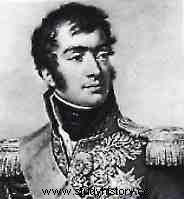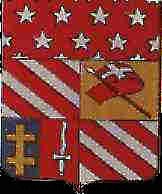July 20, 1774 (Châtillon-sur-Seine) - March 3, 1852 (Venice, Italy)
-

- Marmont, Auguste-Frédéric-Louis Viesse de, Duke of Ragusa
The son of an officer, Marmont graduated from the artillery school in Châlons in 1792, met Bonapane at the siege of Toulon and became his aide-de-camp in February 1796. He followed him to Italy and brought the flags taken back to the Directory. to the enemy during the campaign. Promoted to artillery brigade leader but still aide-de-camp to Bonaparte, he followed him to the East, was made brigadier general in Malta for seizing the flag of the Knights of Saint John. In Egypt, he took part in the main battles and, as commander of Alexandria, pushed back the English fleet on February 3, 1799. Returned with Bonaparte to the Muiron, he took part in the coup d'etat of 18-Brumaire, became State Councilor December 25, 1799 and follows the First Consul in Italy. He distinguished himself at Marengo at the head of the artillery and became general of division in September 1800, at the age of twenty-six. First Inspector General of Artillery in 1802, he commanded the 2nd Corps of the Great Year in 1805, was in Ulm (October 21), Weyer (November 3).
-

- Weapons of Marmont
Governor of Dalmatia, he forced the Russian fleet to lift the siege of Ragusa, which earned him the title of duke of this city in 1808, and organized Dalmatia, a new French possession, creating roads and schools there. In 1809, he pushed the Austrians north, was victorious at Gôspich (May 20), Fiume (May 29), took Graz, commanded the reserve at Wagrarn and inflicted a final defeat on the enemy at Znaim (July 9), what is worth to him to be made Marshal of the Empire on July 12th. Returning to Dalmatia as governor of the Illyrian Provinces, Marmont was sent to the Iberian Peninsula in 1811. He unblocks Ciudad Rodrigo (September 24), invades Portugal and confronts Wellington, arrives as far as Castelo Branco (April 12, 1812) but has to retreat and is beaten at Arapiles (July 22, 1812), where he is wounded. He could not resume a command until the beginning of 1813. He then took part in all the major battles in Saxony, commanding the left wing in Leipzig.
Commanding the 6th corps in the army of Champagne, Marmont was at Brienne (January 29, 1814), La Rothière (February 1), Champaubert (February 10), Vauchamps (February 14), Montmirail (February 17), but his great skill taciiciue is found wanting at Laon (night of March 9 to 10), where he is severely beaten. It was again Marmont who fought the last battles, defended Paris and negotiated the capitulation. Louis XVIII made him a peer of France and Marmont accompanied him during his exile in Ghent. At the second Restoration, he became Minister of State (November 30, 1817), Governor of Paris from 1821 to 1830. He failed to crush the insurrection of July 1830 and went into exile with Charles X. The name of Marmont is inscribed on the Arc de Triomphe of the Star.
